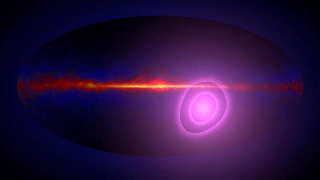Unraveling the mysteries of the universe has always intrigued us. The vast expanse of the cosmos, the twinkling stars, and the nebulous galaxies constantly keep us in awe. In our quest to understand the universe in its full capacity, we often stumble upon phenomena that leave us agog. One such recent revelation is the detection of an unanticipated gamma-ray dipole in the southern sky.
The most likely region where the excess of gamma rays comes from can be seen in purple. (NASA’s Goddard Space Flight Center)
The Enigmatic Gamma-ray Dipole
Gamma-rays, the most energetic form of light, have long been the subject of extensive research. With the power to penetrate matter and emanate from the most extreme environments in the universe, these rays hold clues to some of the most profound cosmic mysteries.
It was in the course of such an investigation that scientists stumbled upon an unanticipated gamma-ray dipole outside our galaxy. This surprising discovery has left scientists both baffled and thrilled, opening up new possibilities for understanding the universe.
The Detection
The detection of the gamma-ray dipole was the result of an analysis of 13 years of data from NASA's Fermi Gamma-ray Space Telescope. The telescope, which scans the entire sky several times a day, provided a wealth of data that allowed scientists to identify and study this intriguing feature.
The scientists were initially looking for a gamma-ray feature related to the cosmic microwave background (CMB), the oldest light in the universe. However, what they found instead was a gamma-ray dipole with a peak located in the southern sky, far from the CMB's location, and with a magnitude ten times greater than what they had anticipated.
This unexpected feature was not what the scientists were originally searching for. Yet, its discovery has led to a flurry of speculations about its origins and potential links to other unexplained cosmic phenomena.
 |
The Fermi Gamma-ray Space Telescope
The Fermi Gamma-ray Space Telescope, managed by Goddard, is a crucial instrument in our quest to understand the universe. Developed in collaboration with the U.S. Department of Energy and several international partners, Fermi has significantly contributed to our understanding of the cosmos.
The telescope is equipped with a Large Area Telescope (LAT) that allows it to scan the entire sky multiple times a day. This incredible capability of Fermi has resulted in numerous breakthroughs in astrophysics and particle physics, including the detection of the unexpected gamma-ray dipole.
The Intriguing Link to Ultrahigh-Energy Cosmic Rays
What makes the detection of the gamma-ray dipole even more interesting is its striking similarity to another unexplained feature – a dipole in the arrival direction of ultrahigh-energy cosmic rays (UHECRs). These cosmic rays carry more than a billion times the energy of 3 GeV gamma rays, and their origins remain one of the biggest mysteries in astrophysics.
The scientists speculate that the gamma-ray dipole and the UHECR dipole may be linked. This potential connection suggests that unidentified sources may be producing both the gamma rays and the ultrahigh-energy particles. To confirm this theory, scientists must either locate these elusive sources or propose alternative explanations for the observed features.
The Cosmic Microwave Background and Its Connection to the Gamma-ray Dipole
The cosmic microwave background, or CMB, has a unique relationship with the gamma-ray dipole. The CMB, which originated when the universe was just a few hundred thousand years old, is the oldest light in the universe. This light has been stretched by the subsequent expansion of space over the past 13 billion years and is now seen in the form of faint microwaves all over the sky.
Scientists initially believed that the gamma-ray dipole might be related to the CMB. However, the discovered gamma-ray dipole was located far from the CMB's location and had a magnitude that was much larger than anticipated. This discrepancy between the expected and observed feature suggests that the gamma-ray dipole might be related to other cosmic phenomena and not solely the CMB.
The Unresolved Mystery and the Way Forward
Despite the exciting discovery of the gamma-ray dipole, its origins and implications remain largely unknown. The potential link to ultrahigh-energy cosmic rays offers a promising avenue for future research. Yet, the identification of the mysterious sources producing these cosmic phenomena remains a formidable challenge.
As we continue to explore the cosmos and uncover its mysteries, discoveries like the gamma-ray dipole serve as a reminder of the vast expanse of the unknown that still awaits us. Every new finding, whether expected or surprising, brings us one step closer to understanding the universe in all its complexity.
Conclusion
The detection of the unexpected gamma-ray dipole in the southern sky is a testament to the power of scientific exploration and the limitless potential of the cosmos. As we continue our cosmic journey, we can look forward to more such exciting discoveries that challenge our understanding and broaden our perspective of the universe.
At FreeAstroScience, we are committed to bringing you the latest and most intriguing developments in the field of astronomy. Stay tuned for more updates as we continue our journey through the cosmos, guided by the passion and expertise of our director, GERD DANI,


Post a Comment